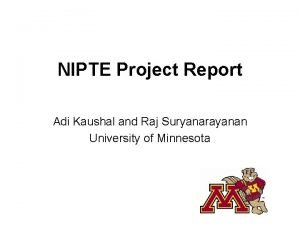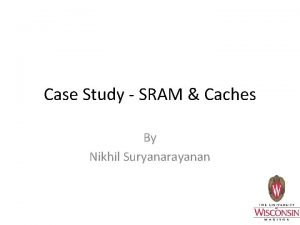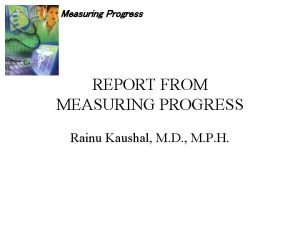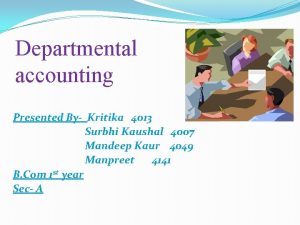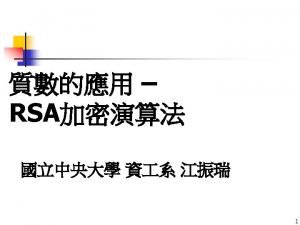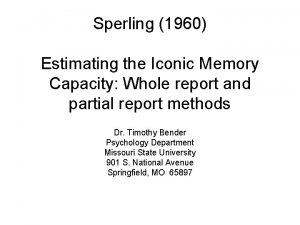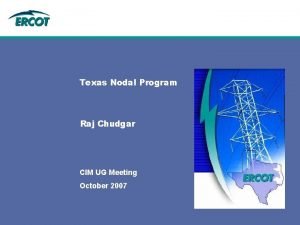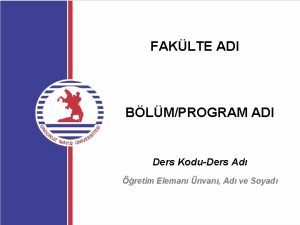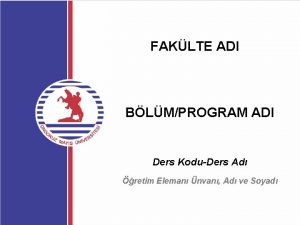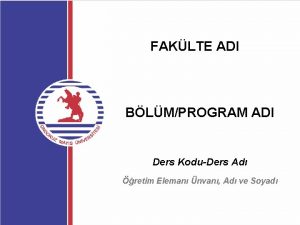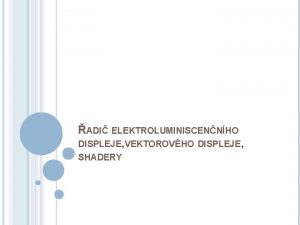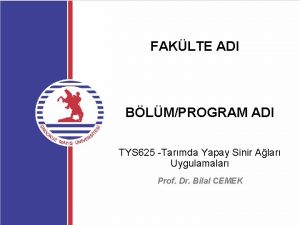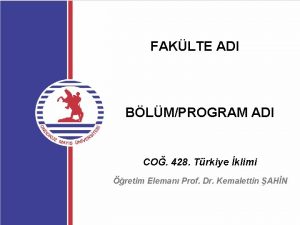NIPTE Project Report Adi Kaushal and Raj Suryanarayanan


































- Slides: 34

NIPTE Project Report Adi Kaushal and Raj Suryanarayanan University of Minnesota

Outline • Inter-conversion of the physical forms • Wet massing – physical transformation • Isomorphic desolvate - challenges with detection Variable temperature XRD • Wet massing followed by drying • Implications on product characterization 2

Form II and I Inter-conversion 3

Water Sorption (Form II) Negligible uptake of water by GBN form II (commercial sample) over a range of RH (0 to 90 to 0 % RH in 10 % RH steps; 3 hrs at each RH) Transformation of form II to form I not likely during handling at ambient RH 4

Intensity (arbitrary units) Contact with Water Solid in contact with saturated aqueous solution – form I GBN ‘as is’- form II 2 (deg) Solid in contact with saturated solution: Instantaneous transformation of form II to form I – Implications on wet granulation 5

Wet massing - granulation 6

Wet Mass During Granulation II I Intensity (arbitrary units) I GBN - form I GBN ‘as is’-form II Wet granules 2 (deg) Form II (1 g) granulated with 0. 3 ml water: Wet mass shows pronounced transformation to form I 7

Dried Granules: Diosna I II I Intensity (arbitrary units) Form II (GBN as received) Form I (GBN-MH-022509 -UM-AMK) Dry Granules (020409 -PU-DKT-Diosno) 2 (deg) Granules from Diosna (dried at RT): Form I persists in dried granules - Content ~80% (based on TGA) 8

Isomorphic Desolvate

TGA: Form I and Partially Dehydrated Phase GBN hydrate (form I) dehydrates slowly at RT – evident by TGA 10

TGA: Form I and Dehydrated Phase Form I after 12 months Form I, freshly prepared GBN hydrate (form I) dehydrates slowly at RT – evident by TGA 11

DSC: Form I and Partially Dehydrated Phase Form I after 12 months Form I, freshly prepared GBN hydrate (form I) dehydrates slowly at RT – evident by DSC 12

DSC: Form I and Dehydrated Phase Form I after 12 months Form I, freshly prepared GBN hydrate (form I) dehydrates slowly at RT – evident by DSC 13

PXRD: Form I and Partially Dehydrated Phase 2 (deg) Dehydrated phase isomorphic to form I – PXRD may NOT be a reliable indicator of phase composition 14

Intensity (arbitrary units) PXRD: Form I and Dehydrated Phase Form I after 12 months Form I, freshly prepared 2 (deg) Dehydrated phase isomorphic to form I – PXRD may NOT be a reliable indicator of phase composition 15

ss. NMR: Form I and Partially Dehydrated Phase ss. NMR can distinguish the isomorphic desolvate from form I 16

Intensity (arbitrary units) Physical Stability of Isomorphic Desolvate GBN MH 022509 Post 50 C/24 hrs GBN MH 022509 (analyzed after 6 mo) GBN MH 022509 (analyzed fresh) 2 (deg) Dehydrated phase resistant to transformation to other forms upon exposure to 50 °C Is the isomorphic desolvate, physically stable in the timescales of our interest? 17

GBN form I - Isomorphic Desolvate • Gabapentin hydrate converts to an anhydrous phase when allowed to slowly dehydrate under ambient conditions • TGA confirms dehydration - no appreciable changes in PXRD SSNMR distinguishes form I from the dehydrated phase • Hydrate present in solid dosage form may convert to anhydrate with subsequent release of water • Possibility of isomorphic desolvate also indicated by variable temperature XRD where the ‘hydrate pattern’ persists above the temperature of complete dehydration in TGA 18

Variable Temperature XRD 19

Variable Temperature XRD - GBN form I Proposed phase transformations during heating of GBN monohydrate 20

Variable Temperature XRD - GBN form I • Form I dehydrates at elevated temperatures to a mixture of polymorphs - form II, III and isomorphic desolvate • PXRD pattern of form I persists above temperature of complete dehydration in TGA – Indicative of isomorphic desolvate • Though dehydration at such elevated temperatures may not be directly relevant pharmaceutically, dehydration of form I over long term storage or processing and under conditions of low water vapor pressure may yield a mixture of polymorphic forms in the final product 21

Wet massing followed by drying 22

In situ granule drying in XRD • Gabapentin form II was wet granulated with water – wet mass was filled into XRD holder and subjected to isothermal hold 35 or 45 ° for about 3 hours. – XRD was recorded at various time points – TGA was performed on the resulting mass after ‘drying’ in XRD 23

Intensity (arbitrary units) Isothermal XRD: Wet mass drying at 35 °C – 150 min 35 °C – 120 min 35 °C – 60 min 35 °C – 30 min 35 °C – 0 min 25 °C Two Theta (deg) 24

TGA: Wet mass dried at 35 °C 25

Intensity (arbitrary units) Isothermal XRD: Wet mass drying at 45 °C – 150 min 45 °C – 120 min 45 °C – 90 min 45 °C – 30 min 45 °C – 0 min 25 °C Two Theta (deg) 26

TGA: Wet mass dried at 45 °C 27

TGA: Comparison Dried at 45 °C Dried at 35 °C 28

Dehydrated Phase of Form I 29

TGA: Dehydration of Form I 30

PXRD: Dehydration of Form I 31

Moisture Sorption: Dehydrated Phase 32

TGA: Dehydrated Phase Dehydrated phase exposed to 75% RH for 48 hours 33

Key Messages • Form I and isomorphic desolvate can form during processing (granulation) of GBN • PXRD is not a reliable indicator of phase composition because of its inability to distinguish between the two forms • The total water content may not be a reliable quality control attribute. The mobility and distribution of water (lattice/free) may be the critical determinants of product performance. • In a formulation matrix, TGA and other characterization techniques will have limited utility for obtaining phase information 34
 Raj suryanarayanan
Raj suryanarayanan Nikhil suryanarayanan
Nikhil suryanarayanan Nikhil suryanarayanan
Nikhil suryanarayanan Rainu kaushal
Rainu kaushal Kaushal bharat ddugky
Kaushal bharat ddugky Surbhi kaushal
Surbhi kaushal Jyoti kaushal
Jyoti kaushal Inter abutment axis line
Inter abutment axis line Status progress report
Status progress report Ron rivest, adi shamir, and leonard adleman
Ron rivest, adi shamir, and leonard adleman Design of connecting rod ppt
Design of connecting rod ppt Plant and machinery valuation
Plant and machinery valuation The summer project is carried out in the
The summer project is carried out in the Cost control and cost reduction project report
Cost control and cost reduction project report Cost control and cost reduction project report
Cost control and cost reduction project report Sperling 1960
Sperling 1960 Ramraj science institute nashik
Ramraj science institute nashik Raj chudgar
Raj chudgar Raj swan
Raj swan Raj swan
Raj swan Pehchan.raj.nic
Pehchan.raj.nic Ravi raj production
Ravi raj production Dr raj thakkar
Dr raj thakkar Panchayati raj institutions accounting software
Panchayati raj institutions accounting software Panchayati raj accounting software
Panchayati raj accounting software Gkv rao committee
Gkv rao committee Raj singamsetti
Raj singamsetti Dr pushpa raj sharma pediatrician
Dr pushpa raj sharma pediatrician Rajesh dave md
Rajesh dave md Raj rajaratnam asha pabla
Raj rajaratnam asha pabla Krc library
Krc library Kandi raj college library
Kandi raj college library Raj rani vs prem adib case summary
Raj rani vs prem adib case summary Dr pushpa raj sharma pediatrician
Dr pushpa raj sharma pediatrician Raj sunderraman
Raj sunderraman
